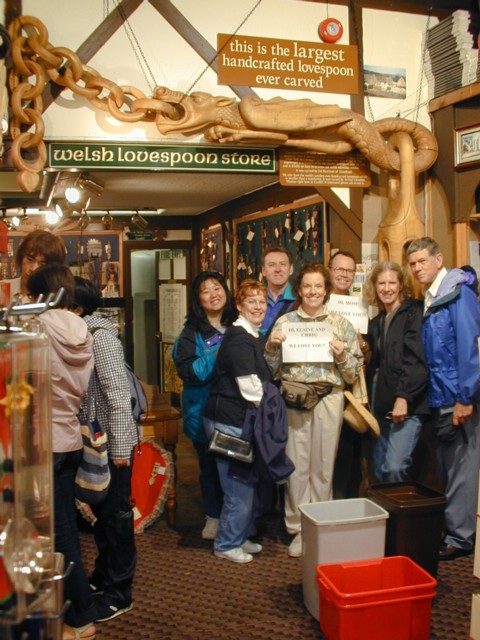

Today we had the whole morning and afternoon free to explore Cardiff and vicinity. Everybody pretty much headed in their own directions; Cheryl and I and the Doughtys headed out shopping first, and we ran into enough choir folks that it seems a lot of us had the same idea. Here we are with the Macks and Belts in a Welsh handcrafts shop (if the photo resolution is too small to read the signs the Belts are holding, well, "Hi, Elaine and Chris! We love you!!" and "Hi, Mom! We love you!!"). The store's specialty is lovespoons, which are a traditional Welsh art form, basically a spoon with a carved handle that is given as a token of love and friendship. The carving can be as simple as a relief design, or as complicated as the skill of the carver allows; the huge carving behind our group is the "handle" of the world's largest lovespoon, made from an entire tree trunk!
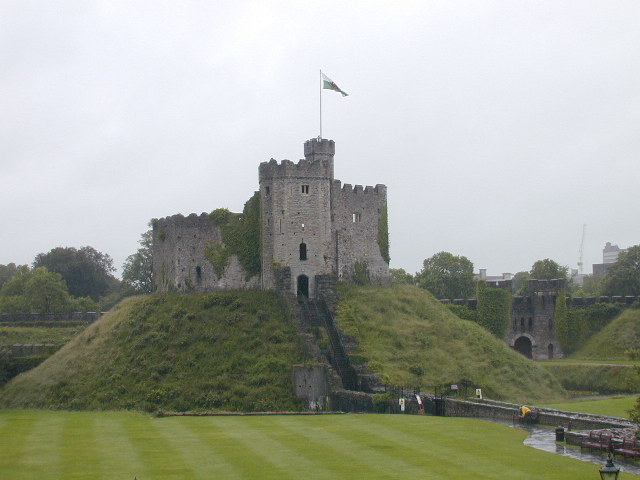
After hitting the handcrafts store, a button store, a knitting store, and probably a few more that I don't remember, we went back to Cardiff Castle, where we had enjoyed a banquet Saturday; we ran into several other choir folks there too. (Apparently some of the information about the origin of the castle, and how it came to be owned by the city, that I originally posted was a bit out of line; I have corrected it on the webpage, so if you printed out a copy please replace it!) The Romans built four forts on this site in the first through third centuries AD; long after they abandoned it the Normans took it over, buried the Roman walls in earthworks, and built the keep shown in this picture on an artificial mound (motte) above a moat within the walls.
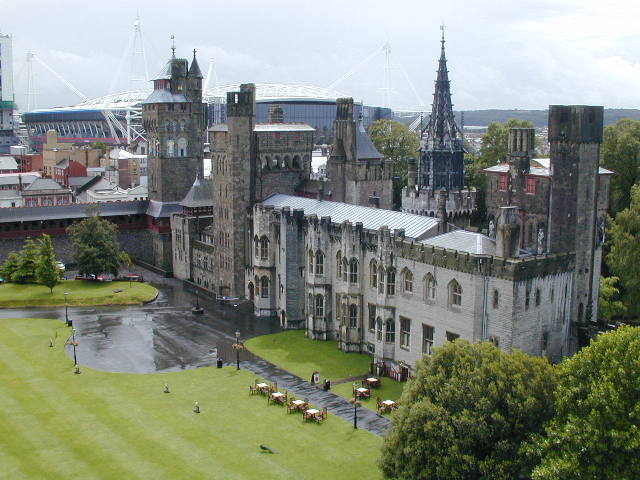
Here is a view of the main castle buildings from the top of the keep; the lower floors were built in the 15th century, and the "Gothic Revival" additions were added in the late 19th century by the third Marquess of Bute. The tour guide described him as "the Bill Gates of Victorian Britain"; the coal fields, railroads, and port of Cardiff and surrounding areas, developed by his father, brought him an income that in modern terms would be several billion dollars per year, and he had ten major landholdings elsewhere in Britain and fifty more worldwide! So he could afford to splurge on a castle here and there. (That's a peacock on the lawn out front; the modern structure in the background is the Millennium Stadium, seat of the national rugby team.) Unfortunately, photography was not allowed inside the castle; imagine a Victorian idealization of the Middle Ages, interpreted with lots of gold leaf and allegory.
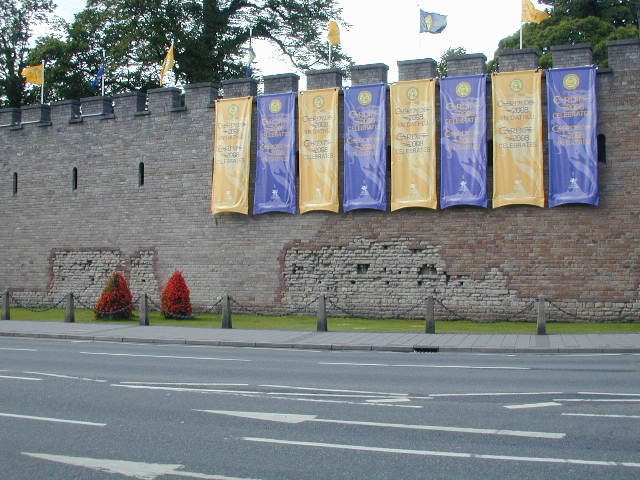
During the extensive construction and renovation of the castle during this period, the Norman earthworks were removed and the remains of the Roman wall brought to light for the first time in almost a thousand years. New walls were erected using the ancient ones as a foundation, and red sandstone blocks were placed to outline the Roman works. After the third Marquess of Bute (and his architect, William Burges) died, his son largely completed the renovations. However, in 1938 the family holdings in the area had to be sold to the government when the coal mines were nationalized, and upon the death of the fourth Marquess the family decided that they didn't need a home in the area (where they had lived only six weeks a year anyway). Since the taxes on a sale would have eaten up most of what was left after paying the inheritance taxes, the fifth Marquess simply gave the castle and grounds to the people of Cardiff.
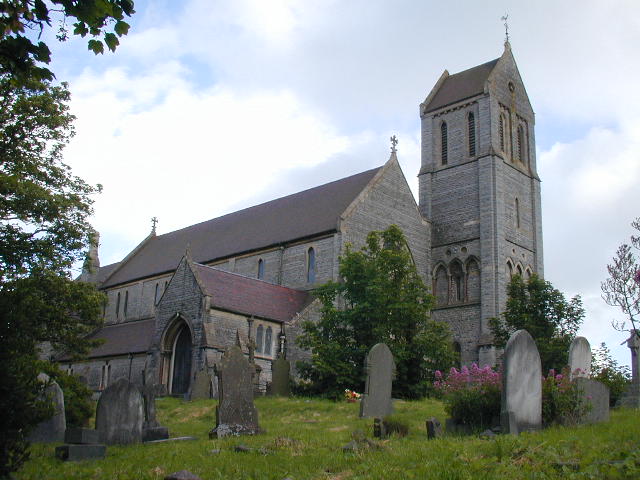
We had planned to take a bus tour of the city, and I understand a lot of choir members did so, but we didn't have time before we boarded our own buses and went to the nearby town of Penarth for our first formal concert, at St. Augustine's Anglican Church.
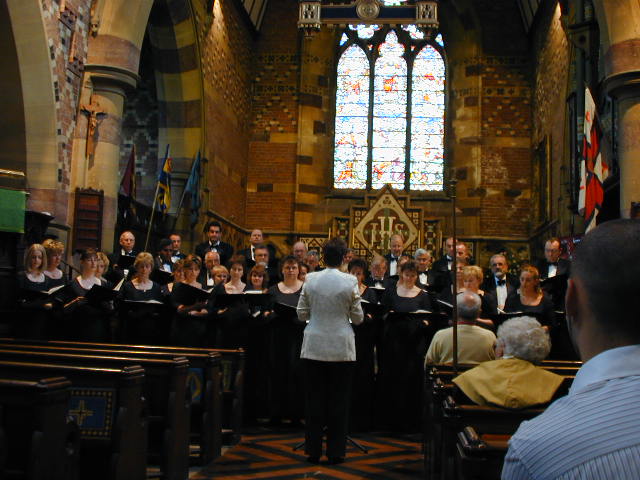
This was a joint concert with the Cardiff Ardwyn Singers, an auditioned choir (like the South Bay Master Chorale) from the local area. (On the journal page I originally posted yesterday I said that we were singing with the same group tonight as we did last night; this was based on a misreading of our itinerary, and I have corrected it on the webpage, so again if you printed it out please go back and reprint it!) The group's sound was absolutely beautiful as they performed a variety of Welsh and international songs (including an African medley that included Siyahamba, which caused us to drop that song quietly from our half of the program!); I might say that they were an intimidating act to follow...
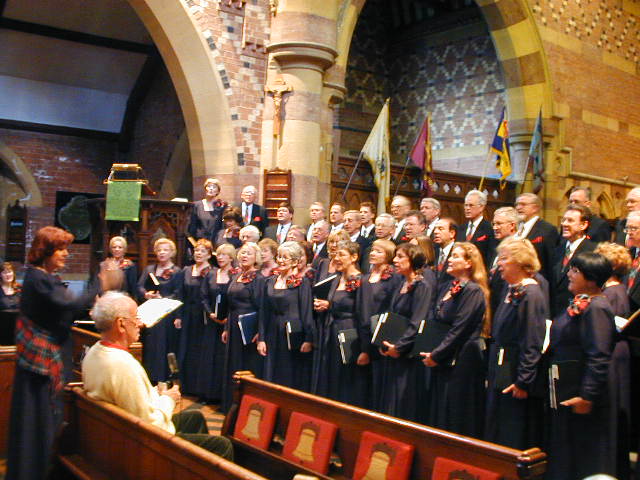
...but follow them we did! As at our previous performances in Britain, we found that our American spirituals, in particular, were well received; also, we saw several audience members singing along with our medley of songs from the 1940s. And, of course, we finished the concert by inviting the audience to join us in singing the Welsh national anthem! (Both of these photos were taken by my wife Cheryl.)
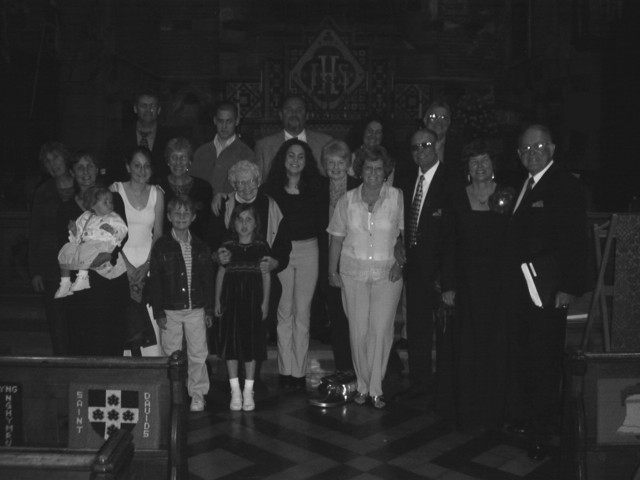
David Evans is, of course, from Wales; at this concert were many members of his family from this area, and his wife Olive joined us too. Here they all are with Pat Edwards, and also with a special friend who has visited MBCC and whom many of you will recognize: standing behind the young lady in the front row is Eluned Phillips, a former Poet Laureate of Wales. (I'm sorry about having to convert the photo to black-and-white; my flash was weak, and by the time I tweaked brightness and contrast to make faces recognizable, the color was unsalvageable...) We then enjoyed a potluck dinner provided at the church's community hall, and returned quite late to our hotel for some well-earned rest.
 To
Tuesday, 2 July 2002
To
Tuesday, 2 July 2002 Back
to choir tour itinerary
Back
to choir tour itinerarynew 1 July 2002, revised 12 July 2002